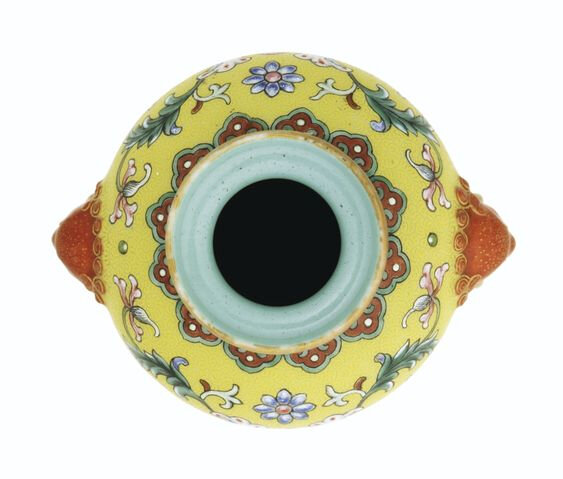An Exquisite Yellow-Ground Famille-Rose Sgraffiato Miniature Vase, Seal Mark and Period of Qianlong (1736-1795)
Lot 15. An Exquisite Yellow-Ground Famille-Rose Sgraffiato Miniature Vase, Seal Mark and Period of Qianlong (1736-1795); 10.8 cm., 4 1/4 in. Estimate 9,000,000 - 12,000,000 HKD (888,611 — 1,184,815 EUR). Lot sold 9,640,000 HKD (951,801 EUR). Courtesy Sotheby's
delicately potted with a tapered narrow foot rising to a wide bulging shoulder surmounted by a short neck and an everted galleried rim, set with two animal-head handles suspending loose gilt rings, finely decorated around the body with a symmetrically arranged flower design incorporating a large fanciful bloom on either side surrounded by feathery leaves interspersed with flower heads and pearls, detailed in white and various tones of rose pink, green, blue and red on a pale lemon-yellow ground finely engraved with dense sgraffiato scrollwork, all below a collar of red ruyi at the shoulder, a border of pale blue key-fret around the waisted neck and a band of curls and dots at the rim, the foot skirted with multi-coloured petal lappets enclosing pearl strings and tassels, the rim, footring and handles picked out in iron red with gold details, the interior and underside glazed in bright turquoise, the base inscribed with a six-character seal mark in underglaze blue within a square cartouche reserved in white.
PROVENANCE: A European Collection (since the 1960s).
Sotheby’s Hong Kong, 8th April 2009, lot 1601.
Eskenazi Ltd., London
LITERATURE: R.P. Marchant, ‘Some Interesting Pieces of Marked Ch’ing Porcelain’, Bulletin of the Oriental Ceramic Society of Hong Kong, no. 3, 1977-8, pls. 17-19.
Regina Krahl, Chinese Ceramics from the Meiyintang Collection, London, 1994-2010, vol. 4, no. 1772.
NOTE: Yangcai porcelains, that is, porcelains with ‘foreign colours’, were Jingdezhen’s answer to falangcai, the exclusive wares decorated in the Forbidden City. The term refers to porcelains formed, fired and decorated at China’s porcelain producing centre, Jingdezhen in Jiangxi province, to specific orders from the court in Beijing. Although in Beijing the Emperors could follow the enamelling process of the porcelains on the spot, the vessels themselves had to be ordered from Jingdezhen. This division of labour over a long distance clearly restricted the type of orders that could be placed, and the constraint quarters in the Forbidden City severely limited the quantity of items that could be produced there.
The Qianlong Emperor therefore increasingly turned to the Jingdezhen kilns directly for his commissions. The highly colourful style of decoration seen on this vase, with its formal flower motifs and the fine engraving to the background, represents one of the rare innovations of the Qianlong reign, and was probably inspired by sgraffiato work on porcelains enamelled in the Beijing palace workshops. According to Peter Y.K. Lam, ‘Towards a Dating Framework for Qianlong Imperial Porcelain', Transactions of the Oriental Ceramic Society, vol. 74, 2009-10, p. 8, the sgraffiato technique began to be used at Jingdezhen in 1741, still during the tenure as Imperial Factory Supervisor of the ingenious Tang Ying (1682-1756), one of China’s greatest innovators in the realm of porcelain.
Vases of this distinct style are known in many shapes, sizes and colour combinations, with variation being so vast that no closely related examples appear to exist. A large variety of yangcai vases with sgraffiato decoration in the National Palace Museum, Taipei, is illustrated and discussed in Liao Pao Show (Liao Baoxiu), Huali cai ci: Qianlong yangcai/Stunning Decorative Porcelains from the Ch’ien-lung Reign, Taipei, 2008, passim.
The present vase is unusual in shape and size, in its finely detailed animal-mask handles and its delicate colour balance. Marchant, op.cit., p. 45, has remarked on the ‘rare pale lavender ground on the false gadroons at the foot of the vase’. A somewhat similar wide open flower as here seen as the focal point of the design, and a similar lavender enamel tone can be seen on the neck of a much larger and differently shaped and painted vase with red-and-gilt dragon handles, sold in these rooms, 1st November 1999, lot 399.
Sotheby's. The Meiyintang Collection, Part V - An Important Selection of Imperial Chinese Porcelains. Hong Kong | 08 avr. 2013

/https%3A%2F%2Fprofilepics.canalblog.com%2Fprofilepics%2F1%2F0%2F100183.jpg)
/https%3A%2F%2Fstorage.canalblog.com%2F03%2F02%2F119589%2F96711876_o.jpg)
/https%3A%2F%2Fstorage.canalblog.com%2F11%2F31%2F119589%2F94773502_o.jpg)
/https%3A%2F%2Fstorage.canalblog.com%2F20%2F83%2F119589%2F94772815_o.jpg)
/https%3A%2F%2Fstorage.canalblog.com%2F26%2F72%2F119589%2F75604929_o.jpg)
/https%3A%2F%2Fstorage.canalblog.com%2F59%2F60%2F119589%2F26458628_o.jpg)








/http%3A%2F%2Fstorage.canalblog.com%2F14%2F63%2F119589%2F120976700_o.jpg)
/http%3A%2F%2Fstorage.canalblog.com%2F16%2F68%2F119589%2F117509711_o.jpg)
/http%3A%2F%2Fstorage.canalblog.com%2F22%2F13%2F119589%2F112910353_o.jpg)
/http%3A%2F%2Fstorage.canalblog.com%2F82%2F96%2F119589%2F112910170_o.jpg)